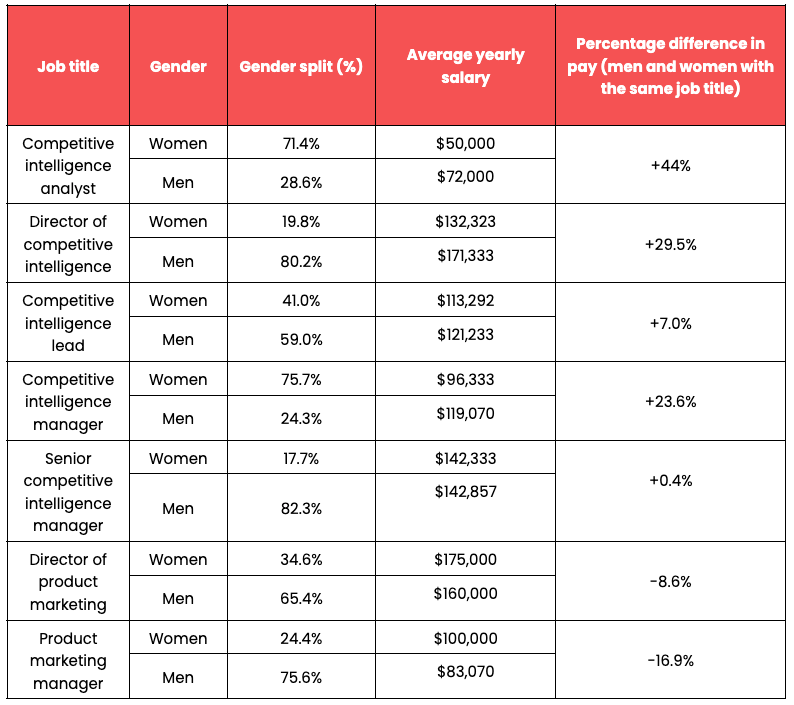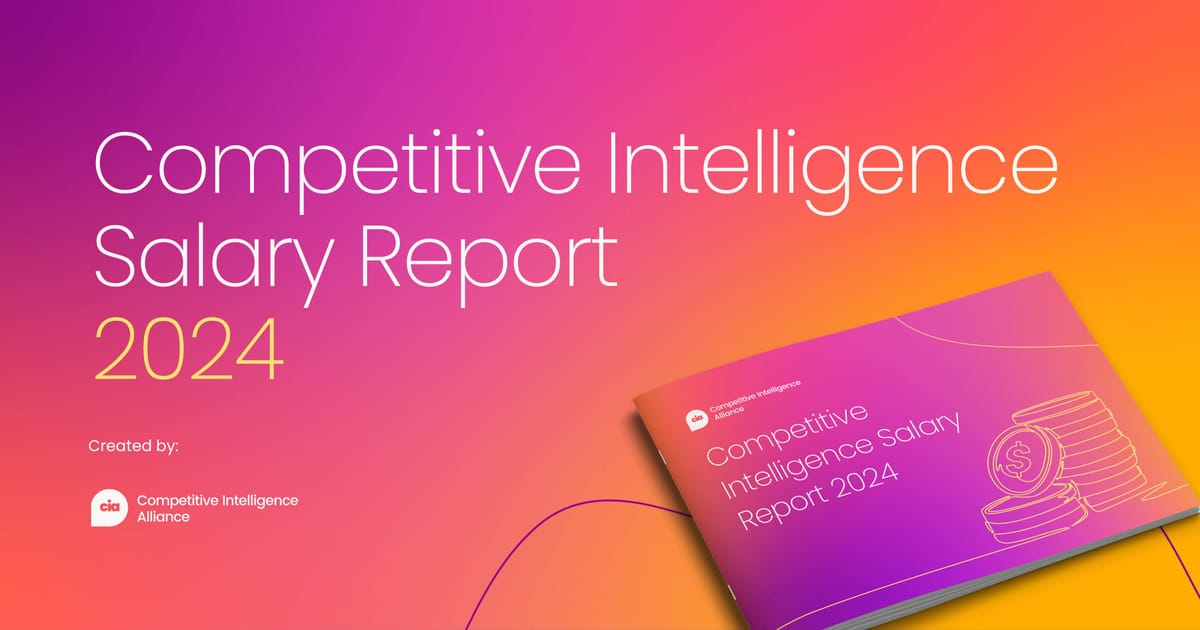In competitive intelligence (CI), a field where strategy and insight are everything, you'd think compensation would be based solely on skill and results. However, the latest Competitive Intelligence Salary Report tells a different story.
If you're a woman in CI, chances are you’re making less than the men in your field – 19.1% less, on average – and that gap has only widened over the past year.
If you’re wondering how this could impact your career and your future in CI, let's break it down.
This article will explore:
- The stark reality of the gender pay gap in competitive intelligence, backed by the latest salary data.
- How the gap varies across different regions and roles within CI.
- Potential reasons behind this disparity (spoiler alert: it's not just about working fewer hours).
- The broader impact of unequal pay on your career advancement and overall satisfaction.
- Practical steps you and your organization can take to help close this gap and create a fairer playing field.
So, stick around.
We’re digging deep into the latest salary findings to find out why, in a field driven by data, the numbers still don’t add up.
Exploring the gender pay gap in competitive intelligence
Let’s start by exploring what exactly the gender pay gap is.
Simply put, the gender pay gap represents the average difference in earnings between men and women. Beyond just a number, it also indicates systemic inequality that can impact everything from workplace morale to career advancement opportunities.
In many industries, this gap shows that women often receive less pay than men for doing the same work. This disparity can lead to long-term effects, including reduced lifetime earnings, lower retirement savings, and a devaluation of women's contributions in the workplace.
Key statistics on the gender pay gap
Let’s dig into the numbers.
The 2024 report reveals that the average base salary for women in competitive intelligence ($100,572) is significantly lower than that for men ($124,297) – a difference of $23,725 or 19.1%. The median salary numbers tell a similar story, with men earning $34,257 more than women.
What’s even more concerning is that this gap has widened since last year. In 2023, the difference in mean salary was notable but not as stark, at $9,650. Clearly, when it comes to the gender pay gap, the trend is heading in the wrong direction, and action must be taken to make salaries more equitable.
Regional differences in gender pay
When we break down the gender pay gap by region, the disparities become even more pronounced.
In Europe, men earn 70.8% more than women, while in Asia, men earn 52.8% more. This isn’t just a matter of a few dollars here and there – it’s a huge difference that can have serious implications for women’s economic security and general well-being.
However, the story is quite different in regions like the Middle East and South and Central America. In these areas, women in CI earn, on average, more than men. In the Middle East, for example, women in competitive intelligence roles earn 51.5% more than men. In South and Central America, the trend is similar, with women earning 19.0% more.
While these figures may seem like positive outliers, they could also indicate a higher representation of women in senior roles in these areas, or they may simply reflect variations in the data due to smaller sample sizes.
These regional differences highlight that the gender pay gap isn’t a one-size-fits-all issue. It varies widely depending on where you are in the world, and understanding these nuances is crucial if we’re going to tackle the problem effectively. Addressing these disparities will require a targeted approach that considers the unique cultural and economic factors at play in each region.
Factors contributing to the gender pay gap in CI
While the numbers show a clear disparity in how much men and women are paid, the reasons behind them are complex. From the distribution of job titles to differences in hours worked, these elements all play a role in shaping the gap. Let’s explore some of the key factors contributing to this issue.
The role of job titles and promotions
One major factor driving the gender pay gap in CI is the distribution of job titles and the pace of promotions.
According to the report, 71.4% of those in analyst roles are women, whereas a whopping 80.2% of directors of competitive intelligence are men. This skew suggests that fewer women are being promoted to higher-paying positions, which significantly contributes to the overall pay gap.
When you consider that the jump from an analyst to a manager, or from a manager to a director, comes with a significant increase in salary, it's clear how staying in junior roles can limit earning potential.
Across all almost competitive intelligence specialist roles, from analyst to director, we found that men are paid more than women. Take a look:

Hours worked and impact on pay
Another factor that often comes up in conversations about the gender pay gap is the disparity in the number of hours worked.
The (often incorrect) assumption is that working longer hours correlates with higher pay, and that women tend to spend less time at their paid jobs so they can spend more time taking care of their families – but what do the stats say?
The 2024 Salary Report shows that 44.8% of men in CI work more than 46 hours a week, compared to just 20.5% of women. At first glance, this might suggest that men are earning more simply because they’re working longer hours.
However, the data shows that there’s more at play here. While men are more likely to work 46 hours or more per week, the report found no consistent correlation between hours worked and pay. In fact, those who work 26 to 35 hours per week were found to earn more than those who work 46 to 50 hours!
This indicates that while working hours might play a part, they don't fully account for the gender pay gap in CI. The gap is likely influenced more by how work is valued and compensated within different roles and levels, rather than just the number of hours put in.
So, addressing CI’s pay disparity problem isn't as simple as encouraging women to work more hours or pursue promotions. Instead, we need to take a closer look at how organizations value different employees and how they can better support women’s career progression.
Broader implications of the gender pay gap in CI
The gender pay gap in competitive intelligence (CI) isn't just a number on a report – it has real-world implications that can affect the entire profession and the organizations that rely on CI expertise. Think that sounds a tad dramatic? Well, let’s explore the consequences of this disparity.
Pay inequality can lead to decreased career satisfaction, as people who feel undervalued may question their worth and place within the organization. This dissatisfaction often translates to lower motivation, reduced engagement, and a lack of enthusiasm for taking on new challenges.
Over time, this can result in a talent drain, where skilled CI professionals – particularly women – seek opportunities elsewhere, where their contributions might be more fairly rewarded. The loss of talent not only disrupts team cohesion but can also negatively impact the quality of insights and strategic decisions the CI function delivers.
What’s more, when organizations fail to address pay inequalities, they risk fostering a work environment where gender biases are perceived as acceptable or even inevitable. This can lead to a toxic culture that undermines diversity, equity, and inclusion efforts, making it even harder for women to break into leadership positions, where they can address these systemic biases.
Study after study has shown that companies with higher gender diversity in leadership teams outperform those that don’t give women a seat at the table. So, addressing the gender pay gap in CI isn't just about fairness – it's about building stronger and more profitable companies.
Ultimately, organizations that recognize the broader implications of pay inequality and take steps to close the gap will be better positioned to attract, retain, and develop top talent, driving better outcomes for their CI functions and the business as a whole.
Addressing the gender pay gap: What can be done?
It's clear that the gender pay gap in CI is a problem that needs addressing. But what's less obvious is how to go about fixing it.
The good news?
There are several actionable steps you and your organization can take to start closing the gap. So, let’s dive into some strategies that can make a real difference.

Promoting transparency and fairness in pay
One of the most effective ways to tackle the gender pay gap is to highlight it. Organizations should implement transparent salary policies that clearly explain how pay is determined and what factors influence compensation and promotions.
When everyone knows what’s required to move up the ladder, it levels the playing field. This clarity can help ensure that promotions and raises are based on merit and performance, not on internal biases.
Regular pay audits are another crucial step. These audits can help identify any disparities in pay between men and women and provide a basis for making adjustments. Think of it as a check-up for your organization’s salary health. Just like you wouldn’t skip your annual physical, companies shouldn’t skip regular reviews of their pay practices.
Encouraging mentorship and support for women
Another powerful tool for closing the gender pay gap is mentorship. By pairing up-and-coming talent with experienced professionals, organizations can help women navigate their careers more effectively and prepare for leadership positions.
A good mentor can help a woman in CI see her own potential, advocate for herself, and pursue the roles she deserves. Organizations should actively encourage mentorship programs and make sure they’re accessible to all employees.
Support doesn’t stop at mentorship, though. Companies need to actively invest in the career development of women within CI. This could mean offering professional development workshops, creating leadership training programs, or simply fostering a culture that values diversity and inclusion.
When companies make it clear that they’re committed to supporting all employees, regardless of gender, it helps create a more equitable workplace.
In the end, addressing the gender pay gap in CI isn’t just a nice-to-have – it’s a must. By promoting transparency, fairness, and support, organizations can help ensure that everyone has the opportunity to succeed, thrive, and get paid what they’re worth.
Want to stop wondering if your earnings are in line with your workload? Find out exactly how much CI pros like you are paid.






.png?v=4917c1c27c)